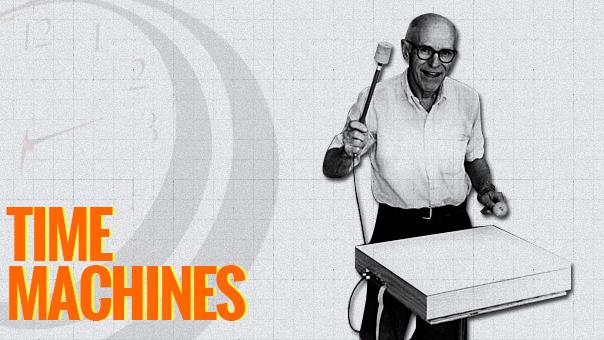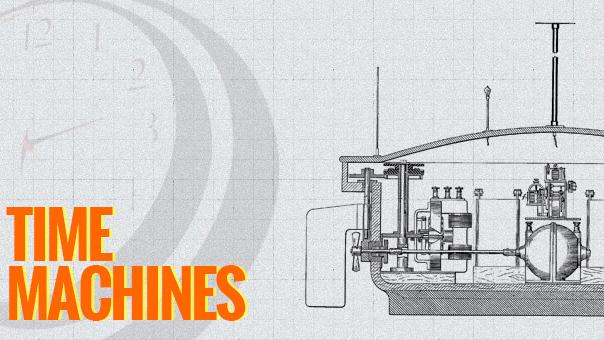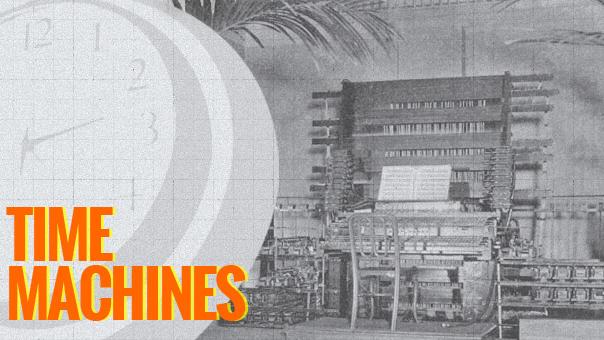TimeMachines
Latest

The sights and scents of the Sensorama Simulator
Welcome to Time Machines, where we offer up a selection of mechanical oddities, milestone gadgets and unique inventions to test out your tech-history skills. You're perched atop a motorcycle, cruising through Brooklyn with the wind whipping through your hair. A faint waft of indefinable city-funk hits your nose and the rumbling of the engine rattles your backside. Then your tokens run out. You've just experienced the Sensorama Simulator, a machine from 1962 that played a 3D film along with stereo sound, aromas and wind in order to create an immersive sensory environment. It was one of many 3D-related creations that visionary inventor and cinematographer Morton Heilig gave the world. His ideas for adding layers of sensory stimuli to augment a simple cinema presentation led the way towards today's "virtual reality" experiences.

Chess and the Automaton Endgame
Welcome to Time Machines, where we offer up a selection of mechanical oddities, milestone gadgets and unique inventions to test out your tech-history skills. Machines may need to start a union. After all, various deep thinkers have been busy for more than a century dreaming up ways to impart human-like thought processes and capabilities into them, just so they can do more of our work. Familiar names in the annals of computing's history such as Charles Babbage and Alan Turing may stand out, but wedged between those figures on the historical timeline is the perhaps lesser-known Spanish inventor and engineer Leonardo Torres Quevedo. Of his many inventions, one of the most unique is "El Ajedrecista" (The Chess Player), which he presented to the Parisian public in 1914. It was a chess-playing automaton, programmed to stand against a human opponent and respond accordingly to any move they made. It knew if someone was trying to cheat, and took pride in moving its own playing pieces around the board. Most of all, it reveled in announcing a victory against its human taskmasters when it inevitably won the game.

Max Mathews' one-man electronic orchestra
Welcome to Time Machines, where we offer up a selection of mechanical oddities, milestone gadgets and unique inventions to test out your tech-history skills. Conduct an electronic orchestra, right from your living room! It may seem like a fever dream headline from the 1950s, but the physical results of Max Mathews' years of work in computer music wouldn't fully materialize until the '80s. His Radio Drum (aka Radio Baton) -- although a continual work-in-progress -- was a groundbreaking method of controlling computer-synthesized sound through a predominantly wireless three-dimensional interface. Many of its unique abilities were courtesy of technological visionary Bob Boie's capacitance research, creating "a much more participatory way of enjoying music," as Mathews described in Stanford University's Brainstorm. The Radio Drum could track surface hits and even hovering positions, and use that data to control a multitude of audio parameters. It was one of many projects that Mathews worked on during his lifetime and played a part in earning him the honorary title of "Father of Computer Music."

GE's bringing good things, and massive robots, to life
Welcome to Time Machines, where we offer up a selection of mechanical oddities, milestone gadgets and unique inventions to test out your tech-history skills. America was in the middle of a post-war economic boom during the '50s and industries were in a rush to build the future, often with outlandish results. RCA-Whirlpool was busy whipping up the "miracle kitchen," chock-full of mod-cons to make the Jetsons jealous, and Simplicity Mfg. Co.'s air-conditioned, bubble-domed lawnmowers arrived to ease the painful process of landscaping. General Electric (GE), a longtime hotbed of innovation and research, had various projects underway, including engineer Ralph Mosher's Cybernetic Anthropomorphic Machine Systems (CAMS). Mosher was building man-amplifying tools that would allow users to control robotic appendages with natural human movement. Not to be left out, the US Army was plotting the future of rough- and remote-terrain vehicles, and it had its eye on GE and Mosher's work.

Tesla's toy boat: A drone before its time
Welcome to Time Machines, where we offer up a selection of mechanical oddities, milestone gadgets and unique inventions to test out your tech-history skills. The military complex has certainly embraced the concept of telerobotics, especially in the use of drones, but luckily the technology has also led to other, more peaceful applications. Drones have been used to entertain, take on laborious tasks and even deliver packages (and burritos!). As we pursue the development of remotely controlled and autonomous craft, we must tread carefully or suffer the same fate as the fabled Icarus. Nikola Tesla saw both the terrible as well as the beneficial consequences for this technology when he debuted the "remote control" and the jury is still out as to whether we'll succumb to a dystopian Terminator-style future or reach a peaceful stasis, where we harness the usefulness of robots and autonomous devices, and avoid the worst-case scenarios.

Time Machines: Casio gets smart at CES 2000
Welcome to Time Machines, where we offer up a selection of mechanical oddities, milestone gadgets and unique inventions to test out your tech-history skills. In the weeks leading up to the biggest gadget show on Earth, we'll be offering a special look at relics from CES' past. Smart devices have infiltrated our outfits in many ways, but one in particular has been a staple of our ensembles for centuries. From pockets to wrists, its accessibility has also tempted inventors to add camera optics, dating as far back as the 1800s. Although we've refined these devices for years, advancements beyond timekeeping tend to come and go. Head past the break for more of the story.

Time Machines: Apple's attempt to sell the future at CES
Welcome to Time Machines, where we offer up a selection of mechanical oddities, milestone gadgets and unique inventions to test out your tech-history skills. In the weeks leading up to the biggest gadget show on Earth, we'll be offering a special look at relics from CES' past. In the early '90s, Apple CEO John Sculley filled his CES keynote with a sweeping premonition on how computers and consumer electronics would soon merge into tiny, do-everything devices. When he finally took the idea to market, it was innovative, ahead of its time and ultimately disappointing. There's more to the story, though, and it's all waiting for you after the break.

Time Machines: NASA goes virtual at CES
Welcome to Time Machines, where we offer up a selection of mechanical oddities, milestone gadgets and unique inventions to test out your tech-history skills. In the weeks leading up to the biggest gadget show on Earth, we'll be offering a special look at relics from CES' past. Our willingness to trade biomass for bits has flourished lately, and nascent virtual reality devices like the Oculus Rift owe at least some of the credit to NASA reasearch and its desire to delve into digital representations of reality. Head past the break for more of the story.

Time Machines: Atari's CES Endgame
Welcome to Time Machines, where we offer up a selection of mechanical oddities, milestone gadgets, and unique inventions to test out your tech-history skills. In the weeks leading up to the biggest gadget show on Earth, we'll be offering a special look at relics from CES' past. Atari, a once seemingly untouchable gaming company, was beset by problems during the early '80s and saw its last chance for salvation in a fresh console release. It pitched this device, along with a very unique controller, at CES in 1984, but never managed to regain its footing in the industry. Head on past the break to find out more.

Time Machines: Dial-a-tune
Welcome to Time Machines, where we offer up a selection of mechanical oddities, milestone gadgets and unique inventions to test out your tech-history skills. This invention brought streaming music to New York City's early adopters around the turn of the 20th century. Mark Twain, who was among the first to have a personal telephone line installed, was an avid supporter of the service, which provided the crystalline clarity of electrically generated music delivered into his own home on the telephone wire. Head on past the break to find out the full story.

Time Machines: Say 01100011 01101000 01100101 01100101 01110011 01100101!
Welcome to Time Machines, where we offer up a selection of mechanical oddities, milestone gadgets and unique inventions to test out your tech-history skills. Today the world can easily be captured in 1s and 0s for our viewing pleasure. The hardware behind this capability all started as a DIY lab project in 1974 to test out some new gear, and the result was a Frankenstein-like device that would eventually lead to world-changing advances in photographic technology. Head on past the break for the full story.

Time Machines: Silver platters
Welcome to Time Machines, where we offer up a selection of mechanical oddities, milestone gadgets and unique inventions to test out your tech-history skills. It bears a passing resemblance to the vinyl record, but this futuristic concept was envisioned as more than just sound on a platter. The recording method involved electron beams and lasers; the base material was a coated, transparent plastic disc; and you'd get both an eyeful and an earful from the end product. Its intended goal in the market may have initially flubbed, but its core design has been patently embedded into a variety of successful formats ever since. Take a spin past the break to find out more about this invention.

Time Machines: The military sphere
Welcome to Time Machines, where we offer up a selection of mechanical oddities, milestone gadgets and unique inventions to test out your tech-history skills. If you've ever played the arcade version of Missile Command or used a mechanical mouse, then you've sampled technology that originated in a secret Canadian military research project back in the '50s. The device was a key component in a radar display interface that allowed operators to maneuver an on-screen cursor with speed and accuracy to identify targets. Roll on past the break for the full story behind this device.

Time Machines - Wireless wonder
Welcome to Time Machines, where we offer up a selection of mechanical oddities, milestone gadgets, and unique inventions to test out your tech-history skills. This device famously exhibited the potential of tuned radio waves and their ability to wirelessly convey a signal. In 1899, it transmitted a message successfully from Britain, across the English Channel's 32-mile expanse, to a receiver in France. Its business-minded inventor went on to pioneer an industry in communication that changed the world. Tune in past the break for more about this breakthrough gadget.

Time Machines: A PC pioneer
Welcome to Time Machines, where we offer up a selection of mechanical oddities, milestone gadgets, and unique inventions to test out your tech-history skills. This digital device was released in 1971, just prior to the announcement of the first commercially available microprocessor. It offered a personal computing experience at a relatively affordable price and, in 1986, it was selected as the winner in the Computer Museum's "Earliest PC Contest." Head past the break for more on this piece of computing history.

Time Machines: Artificial beats
Welcome to Time Machines, where we offer up a selection of mechanical oddities, milestone gadgets, and unique inventions to test out your tech-history skills. Over three decades ago, this device helped blur the lines between man and machine when it was successfully implanted into a patient to replace a failing organ. Head on past the break to get to the heart of the matter.

Time Machines: Orbital enabler
Welcome to Time Machines, where we offer up a selection of mechanical oddities, milestone gadgets, and unique inventions to test out your tech-history skills. The design may seem to be rooted in the dark side, but this communications satellite was a force for global good. It relayed the world's first transatlantic TV signal and tested the orbital waters for future satellite development. Think you know what it is? Head past the break to find out.

Distro Issue 45: a brief history of Motorola and WWDC 2012's top stories
Still recovering from last week's barrage of fitness gadgetry? Yeah, we are too. This week, we take a less active approach to the latest issue of our tablet mag. Motorola's influence on the tech that we all know and love extends far beyond flip phones and pagers. Our own Brian Heater takes a look at the history of the company in the issue's editorial feature, offering a glimpse into the timeline that led up to Google's $12.5 billion purchase. The folks in Cupertino had an event a few days back that offered a handful of juicy tidbits -- to say the least. If you fear you might've missed something or just need a quick refresher, we run down WWDC's 10 most important talking points. Speaking of which, the "Hands-on" section this week is devoted entirely to the next-gen MacBook Pro with Retina display -- in case you've been napping and haven't had a look for yourself. In terms of device reviews, we offer our thoughts on both the Sony Xperia P and Xperia U for your weekend read. If you're still reminiscing about E3, "Reaction Time" looks at Ubisoft's new title in a week that chock-full of sequels while "Eyes-on" takes a gander at the Nest thermostat and "Time Machines" visits the roots of the TI-30X IIS. The download links are just a click away, so hit yours to get started. Distro Issue 45 PDF Distro in the iTunes App Store Distro in the Google Play Store Distro APK (For sideloading) Like Distro on Facebook Follow Distro on Twitter

Distro Issue 43 has arrived with Thomas Dolby: TED talks, cellphone deals and the Floating City
What's that? You've already worked your requisite 40 hours this week and you're ready to throw in the towel? Well, we've got something far more enjoyable for your Friday afternoon relaxation. Hot off of the e-presses, this week's issue of Distro is packed with a week's worth of leisurely readings. The focus this time around is on Thomas Dolby and our own Brian Heater details the '80s pop star's journey back to the stage with TED, cellphones and his own virtual world. As far as reviews go, we spend some quality time getting to know the latest Chrome OS arsenal from Google, ASUS Zenbook Prime UX21A and the highly anticipated Samsung Galaxy S III. Our hands-on section is still a young Padawan, but this week we breakdown Nokia 808 PureView sample shots and the recently outted Facebook Camera app. Do you have gaming on the brain with E3 less than a week away? If so, Reaction Time should hold you over with new releases and a discussion of the aforementioned gaming expo. Stat takes a look at copyright and piracy claims, we go eyes-on with the Lumia lineage, BAROBO's Graham Ryland stops by for the Q&A, Switched On tackles Cisco, IRL let's you get cozy with our gear and Rehashed looks back at the week that was in 140 characters or less. The days are winding down until it'll be too hot to enjoy that hammock, so don't waste any more time. Hit your weekly download link and snag a copy of our tablet mag. Distro Issue 43 PDF Distro in the iTunes App Store Distro in the Google Play Store Distro APK (For sideloading) Like Distro on Facebook Follow Distro on Twitter

Distro Issue 42 lands with the Engadget Summer Gear Guide, a handsome new look and more!
Get ready, folks. We've got quite the treat for you this week. Not only do we have a brand spanking new issue of our weekly for your peepers to consume this weekend, but we've redesigned said e-publication as well. Of course, the real star this week is the Summer Gear Guide. That's right, our editors have painstakingly selected their top choices in all of the major categories to keep you blazin' the balmy trail with the best gadget arsenal possible. To go along with the refined digs, we introduce some new pages this week, too. Time Machines will test your geek cred by removing the easily identifiable logos from a classic device for your trivia pleasure. We'll also go eyes-on each week with some quite dapper offerings to satisfy the design nerd inside us all. Speaking of recent additions, we break down our recent hands-on impressions while Reaction Time offers some thoughts on next-gen gaming and upcoming releases. Switched On chats about what's next for Facebook, the Stat tallies the rise of mobile apps in the last year, Fusion-io CEO and Chairman David Flynn admits his love of Flowbee in the Q&A and Sean Pryor returns for The Strip. So, what are you waiting for? Hit the download link below that you fancy the most and you'll have a copy of this week's e-magazine before you know it. Distro Issue 42 PDF Distro in the iTunes App Store Distro in the Google Play Store Distro APK (For sideloading) Like Distro on Facebook Follow Distro on Twitter

